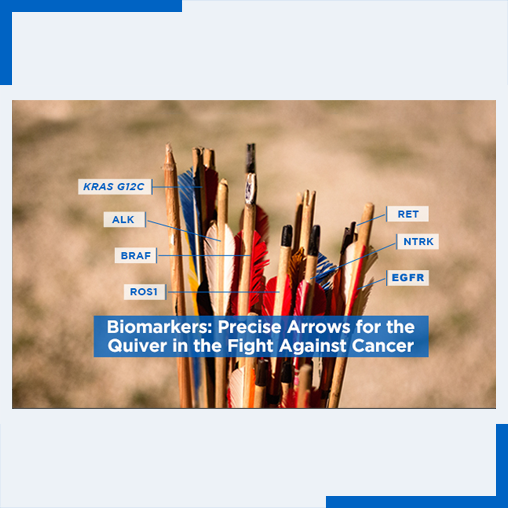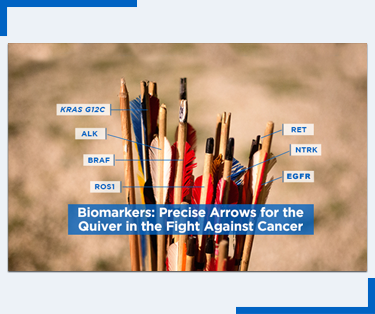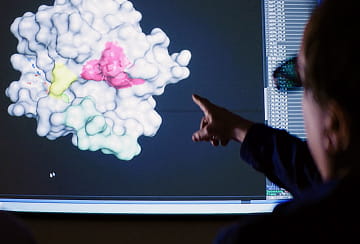Lung cancers are among the most common and deadly cancers, accounting for nearly a quarter of all cancer deaths in the U.S. At the same time, there have also been significant advancements in personalized cancer medicine for patients with lung cancer. Cancer researchers have uncovered biomarkers from the lung biopsy samples of patients with lung cancer that can help guide personalized treatment options. Biomarker-driven treatments have led to improved outcomes for some patients with lung cancer.
“Biomarker testing has become a vital part of the treatment decision-making process for patients diagnosed with lung cancer,” says Byeong Yoon, executive director, platform lead for biomarkers, in Oncology Global Medical Affairs at Amgen. “Lung cancer has become a leading example of the importance of comprehensive biomarker testing and continuing to identify clinically relevant biomarkers may be critical for improving patient outcomes.”
What are biomarkers and how do they impact a patient’s treatment plan?
A biomarker (or biological marker) is an attribute that can be clinically measured to provide more information about a patient’s disease. In oncology, biomarkers can include genetic mutations that may predispose a person for a certain cancer, such as BRCA gene mutations in connection to breast cancer. Mutations that occur within the DNA of tumor cells may predict responses to a particular therapy, such as EGFR inhibitors for patients with tumors that have EGFR mutations.
“Saying a patient has lung cancer is like describing a person by the city they live in — it doesn’t say much about who that individual really is,” explains Greg Friberg, vice president and head of global development for the hematology/oncology therapeutic area at Amgen. "Fingerprints, eye color — those provide more specific details about a person. Similarly, biomarkers give us information about a tumor that, increasingly, doctors can use to match individual patients with the therapies that may benefit them most.”
Biomarkers have advanced precision medicine in lung cancer, but significant unmet needs remain
Before the era of precision medicine, oncologists could only differentiate two types of lung cancers based on their histologies: non-small cell lung cancer (NSCLC) and small-cell lung cancer (SCLC). Today, there are more than 10 known variants, almost all of them subsets of NSCLC classified by mutations such as EGFR, ALK, BRAF, ROS1, RET, NTRK and KRAS G12C.

A majority of therapies approved over the last decade for patients diagnosed with NSCLC have been therapies that target a specific mutation. But despite exciting advancements over a relatively short period of time, only 25% of patients with NSCLC have an actionable mutation for which there are currently approved therapies.
Continued investigation into identifying new biomarkers is needed to grow the number of targets, and the ongoing development of therapies against known and emerging biomarkers can help bring precision medicine to more patients.
“Cancer is a vicious beast that can adapt to the things we throw at it, so we need multiple arrows in our quiver," Friberg says. “And it can’t just be a bunch of arrows that do the same things. We need many different mechanisms that create opportunities to come at these tumors from many different angles."
Amgen’s work on emerging biomarkers KRAS G12C and DLL3
Emerging biomarkers represent the leading edge of efforts to add more types of arrows to the quiver for patients with lung cancer. The KRAS oncogene was one of the earliest known oncogenes. It’s also one of the most commonly mutated oncogenes, with KRAS mutations found in about 25% of patients with NSCLC. Scientists have spent decades trying to develop a drug that could target mutated KRAS. Amgen scientists were the first to bring an investigational KRASG12C inhibitor into clinical testing, with the CodeBreaK clinical trials.
There are currently no approved targeted therapies for analogous tumor biomarkers in SCLC. However, the expression of the DLL3 protein, an emerging biomarker, may become the first. “What we see in some neuroendocrine tumors like SCLC is they start to express a lot of this protein, DLL3,” Friberg says. “It’s not a mutation, but since there is more DLL3 on the surface of the tumors, it may act like a flag that we can potentially take advantage of using antibody-based therapies.”
The development of a therapy that targets DLL3 would be a significant milestone for patients with SCLC, and Amgen is currently conducting early trials of its Bispecific T Cell Engager (BiTE®) technology, targeting DLL3 in SCLC. BiTE® molecules are specially engineered antibodies that target a specific tumor-associated antigen, such as DLL3, at one end, while the other end signals the body’s own T cells to attack the cells expressing the antigen.
Overcoming barriers to biomarker testing
Over the last decade and beyond, science has clearly demonstrated that using personalized treatments against specific genetic profiles leads to an improved chance of fighting those tumors. Yet, even in lung cancer, with many approved therapies for known biomarkers, many patients still go untested, or don’t receive the appropriate targeted therapy even if they are tested.
"There are a number of reasons why we still see gaps in molecular testing for biomarkers,” Yoon says. “In some cases, not all physicians, particularly those that treat many tumor types, may be up-to-date about the latest advancements in actionable biomarkers. There are also operational reasons, such as not having enough tissue for testing, long turnaround times for test results, insufficient communication between departments or concerns over reimbursement.”
Overcoming these gaps in biomarker testing requires a multipronged approach that includes education for the medical community, efforts to ensure comprehensive biomarker testing is available for all patients, and that all patients have access to the appropriate therapies recommended by their tumor profile.
“At Amgen, we’re working on educational programs about the importance of comprehensive biomarker testing for specific guideline-recommended biomarkers," Yoon says. "We're also looking to uncover additional insights through stakeholder engagement into why gaps continue to exist that limit the ability for patients to be tested at diagnosis."
As the science advances, biomarker testing is becoming more comprehensive, convenient and accessible for a greater number of patients. Broad panel tests that can search for all known targetable and emerging mutations in a single test are available rather than only single-gene tests, while innovations in liquid biopsy make it possible to test some tumors through a blood test rather than requiring an invasive tissue biopsy.
“We’re learning more about tumors, not only what their gene sequences are, but what makes them tick, and our understanding of these biomarkers gives us the chance to personalize therapies with molecular tools,” Friberg says. “It will take a commitment to the science to make the big leaps forward, but I can’t think of anything more exciting than taking an innovative, science-based approach with the goal of helping people who are suffering from serious illnesses like lung cancer.”





